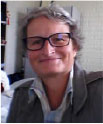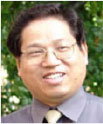35th Australasian Polymer Symposium (APS) Research Highlights
Amanda V. Ellis A C and Greg G. Qiao B CA Flinders Centre for Nanoscale Science and Technology, Flinders University, Sturt Road, Bedford Park, Adelaide, SA 5042, Australia.
B Department of Chemical and Biomolecular Engineering, University of Melbourne, Parkville, Vic. 3010, Australia.
C Corresponding authors. Email: amanda.ellis@flinders.edu.au; gregghq@unimelb.edu.au

Professor Amanda Ellis graduated with a Ph.D. in applied chemistry from the University of Technology, Sydney, in 2003. She undertook two post-doctoral positions in the USA (Rensselaer Polytechnic Institute and New Mexico State University) and one in New Zealand (Industrial Research Ltd (now Callaghan Innovations)). In 2006, Amanda commenced at Flinders University where she is currently an Australian Research Council Future Fellow (2014–2018). She was also the past-Chair of the RACI National Polymer Division (2013–2015) and the Convenor of the 35th Australasian Polymer Symposium in 2015. |

Professor Greg Qiao is a professor and Assistant Dean (Research) in the Melbourne School of Engineering at the University of Melbourne. He is also Deputy Head of the Department of Chemical and Biomolecular Engineering. Greg is currently the Chair of the RACI National Polymer Division and Convenor for the 36th Australasian Polymer Symposium in 2016. |
Australian Journal of Chemistry 69(7) 699-700 https://doi.org/10.1071/CHv69n7_FO
Published: 6 July 2016
Abstract
This introduction sets the background to this special issue containing papers collected from the 35th Australasian Polymer Symposium (35APS) which was held on the Gold Coast, Queensland, from 12 to 15 July 2015. These works illustrate both the multidisciplinary nature and the breadth and depth of contemporary polymer science and engineering that was discussed at this meeting.
The 35th Australasian Polymer Symposium (APS) took place on the Gold Coast, Queensland, from 12 to 15 July 2015, and encompassed three-and-a-half days of stimulating presentations covering numerous areas of polymer science. There were 260 delegates from Australia and around the world in attendance, with six plenary speakers and 24 keynote speakers, five of whom were early career researchers. The plenary speakers included Professor Mitch Winnick from the University of Toronto, Canada, talking about his work investigating metal-chelating polymers and their potential for biological applications of sensing and imaging. Professor Yanlei Yu from Fudan University, China, spoke on the field of liquid crystal polymers, which are crystalline aromatic polyesters that form areas of highly ordered structures when in the liquid phase. Professor Bjorn T. Stokke from the Norwegian University of Science and Technology, Norway, gave a plenary lecture on responsive polymer hydrogels. Professor Benjamin Hsiao from Stony Brook University, New York, USA, provided an example of the translation of laboratory to industry with his work on nanofibrous membrane filters for high-flux water purification. Professor Werner Joseph Blau from Trinity College, Dublin, Ireland, described his interdisciplinary work with materials science and physics in the development of nanocarbons and atomic crystals. Finally, Professor Mats Andersson from the Future Industries Institute, Adelaide, Australia, discussed his work on polymeric materials for energy and conducting applications.
The topics covered in the symposium exemplified the diversity of our discipline, including photopolymerisation, advanced characterisation techniques, biomaterials, drug delivery, polymers for bioimaging and biomedical applications, novel synthetic techniques, and industry and innovation.
The six papers published in this special issue of Aust. J. Chem. include a report from plenary speaker Professor Mats Andersson on the ‘Stability of Polymer Interlayer Modified ITO Electrodes for Organic Solar Cells’.[1] A highlight paper by invited keynote speaker Professor Christine Luscombe entitled ‘Poly(3-hexylthiophene) End-Functionalization via Quenching Resulting in Heteroatom-Bond Formation’ illustrates how changing the end-functional groups of P3HT to incorporate chalcogens opens up the opportunity to control and alter interactions with different materials.[2] Two review articles from early career researchers include Dr Katherine Locock’s (CSIRO, Melbourne, Australia) review entitled ‘Bioinspired Polymers: Antimicrobial Polymethacrylates’ which traces the development of the antimicrobial polymethacrylates from the initial mimicry of global cationic and lipophilic AMP properties through to the level of specific amino acids present in the peptides.[3] Dr Luke Connal’s (University Melbourne, Australia) review entitled ‘Amino Acid Functional Polymers: Biomimetic Polymer Design Enabling Catalysis, Chiral Materials and Drug Delivery’ focusses on the design and synthesis of polymers functionalised with amino acids.[4] Dr Connal also presents a communication paper on ‘Phase Separated Block Copolymer Particles with Tuneable Morphologies: Striped, Onion and Patchy Particles’ which highlights how morphologies of poly(2-vinyl pyridine)-block-poly(dimethylsiloxane) diblock copolymers can be tuned by controlling the interfacial energy using functional surfactants.[5] The RACI Trelaor Best Poster prize winner, Molly Rowe, from the University of New South Wales, Australia, presents a research paper entitled ‘High Glass Transition Temperature Fluoropolymers for Hydrophobic Surface Coatings via RAFT Copolymerization’.[6]
References
[1] A. Sharma, Z. George, T. Bennett, D. A. Lewis, G. F. Metha, G. G. Andersson, M. R. Andersson, Aust. J. Chem. 2016, 69, 735.| Crossref | GoogleScholarGoogle Scholar |
[2] L. J. Kang, C. K. Luscombe, Aust. J. Chem. 2016, 69, 701.
| Crossref | GoogleScholarGoogle Scholar |
[3] K. E. S. Locock, Aust. J. Chem. 2016, 69, 717.
| Crossref | GoogleScholarGoogle Scholar |
[4] E. R. L. Brisson, Z. Xiao, L. A. Connal, Aust. J. Chem. 2016, 69, 705.
| Crossref | GoogleScholarGoogle Scholar |
[5] C. Chen, Z. Xiao, L. A. Connal, Aust. J. Chem. 2016, 69, 741.
| Crossref | GoogleScholarGoogle Scholar |
[6] M. Rowe, G. H. Teo, J. Horne, O. Al-Khayat, C. Neto, S. C. Thickett, Aust. J. Chem. 2016, 69, 725.
| Crossref | GoogleScholarGoogle Scholar |


